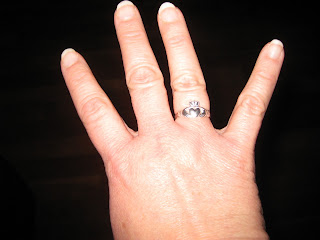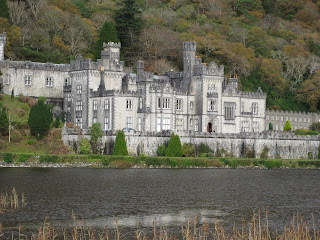My last guest of the fall, Paula, left on Saturday. We had a marvelous time. Although we did many of the same things I have done with others, such as tours of Connemara and the Cliffs of Moher, I continued to learn a lot and I enjoyed each outing immensely. We ate wonderful food, listened to live, traditional music and watched traditional dancing. We also enjoyed ridiculously uncharacteristic weather. It hardly rained while Paula was here!
 |
| Paula and Rachel at Cliffs of Moher |
 |
| Rachel at Ross Errilly Friary |
 |
| Paula in Cong, the town where "The Quiet Man" was filmed |
 |
| Rachel and Paula at Dunguaire Castle |
 |
| Tombs at Kilfenora |
 |
| Paula likes rock walls, too! |
 |
| I still want one of these in my yard! |
 |
| Sweetie Pies for afternoon tea |
We spent the last two nights of Paula’s visit in Dublin. After reading my “Beauty and Tragedy in the Connemara Region” blog, my friend Betty Peterson emailed me and commented that I have picked up on the “Irish way of ‘tears and laughter.’” I was reminded of her phrase when I was in Dublin.
Paula and I began our first full day in Dublin at the Guinness Brewery. I don’t really like beer, but I found the visit great fun. We learned about the history of the 251 year old business, tasted the product, pulled our own pint, ate lunch and shopped in the Guinness store. This was definitely the laughter of the day.
 |
| An advertisment |
 |
| Paula going for the black! |
 |
| Paula pulls a pint of Guinness |
 |
| Rachel shows off the pint she pulled and the certificate that proves she did it |
 |
| Shopping! |
 |
| The fruits of Paula and Rachel's Christmas shopping (there may be a thing or two in there for us...) |
I experienced tears at our next stop, Kilmainham Jail. Aideen, the friendly and helpful woman who works at the jewelry store in Galway, recommended that Paula and I tour the jail. Aideen has never steered me wrong. I knew the tour would be educational and difficult. Right on both counts.
Kilmainham opened in 1796 and closed in 1924. The jail design, a panopticon, was inspired by the work of Jeremy Bentham. A panopticon prison is designed with cells built around a center guard station. Bentham reasoned that if a prisoner might be watched at any time, s/he would behave as if s/he was watched because s/he does not know when s/he is under surveillance. In other words, the prisoner will self-monitor. I have discussed this type of prison for years in my Organizational Communication class because French Post-Modernist, Michel Foucault, posited that we live in a panopticon society and therefore we discipline ourselves. Though I have known of this prison design, I had never actually seen it in person.
The only way to tour Kilmainham Jail is with a guide. Our tour guide brought many stories to life. We learned of the youngest prisoner, an eight-year old girl sentenced to five months for stealing a lady’s cloak to keep warm. We learned that upon arrival, each prisoner was given a Bible (most could not read), a thin blanket and a candle. The candle was supposed to last for two weeks and was the prisoners’ source of light and heat. Prisoners were often afraid to light the candle because they feared that the next day might be even colder than the current one. We saw the exercise yard where prisoners were led for an hour a day. Their exercise consisted of forming two concentric circles and walking around and around. Prisoners were not allowed to talk to or look at each other; they had to look at their feet as they walked.
The leaders of the 1916 Easter uprising were imprisoned and executed by firing squad at Kilmainham. Early in our tour we were shown to the jail’s Catholic Chapel where we sat down to listen to our guide. Our guide shared a great deal of history and told us the story of Joseph Plunkett and Grace Gifford. Joseph and Grace were engaged to be married on Easter Sunday, 1916, the day of the Easter Rising. Joseph was a leader of the uprising and was arrested before they could be married. The couple was allowed to marry in the chapel at the jail on the night before Joseph was executed. They were not allowed to talk to each other, though. Later that night, the guards allowed Grace to spend ten minutes with her new husband. They were not left alone and the guards counted down each of the ten minutes. After their brief time together, Grace stayed near the jail until she heard the shots ring out that killed her husband. I’m pretty sure I heard other people sitting in the chapel rustling around as they hunted for tissue, but I can say unequivocally that I was brought to tears and I fished a tissue from my bag.
We ended our tour of the jail in the outdoor and walled area where executions were carried out. A black cross marked the place the Easter Rising rebels were executed. In the yard hung an Irish tri-color flag. Our tour guide explained that the green stands for those who wish for a full union of all of Ireland. The orange represents those who continue to support British rule and the white in the center stands for peace between the two.
When I was in the Guinness Brewery I snapped picture after picture. Though our tour guide suggested things we might want to photograph, I could not bring myself to take even one shot of Kilmainham Jail. Everywhere I walked I felt sorrow and pain and injustice emanate from the cold stones. I just didn’t think a photograph could adequately capture what I experienced and it felt almost disrespectful to those who suffered in that place.
I discussed Kilmainham jail with an Irishman I met on Saturday night at a Thanksgiving dinner. The man, Robert, told me about a poem by WB Yeats about the Easter Rising. It seems many Irish were unprepared for the uprising and they did not initially view the rebels in a positive light. The executions, however, turned the rebels into martyrs and this led to support for the rebels. The Yeats poem, “Easter, 1916” captures this change of heart. Here is the opening stanza of the poem:
I have met them at close of day
Coming with vivid faces
From counter or desk among grey
Eighteenth-century houses.
I have passed with a nod of the head
Or polite meaningless words,
Or have lingered awhile and said
Polite meaningless words,
And thought before I had done
Of a mocking tale or a gibe
To please a companion
Around the fire at the club,
Being certain that they and I
But lived where motley is worn:
All changed, changed utterly:
A terrible beauty is born.
































